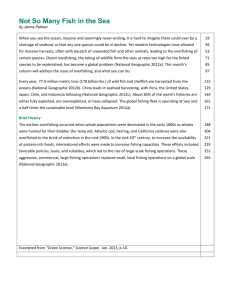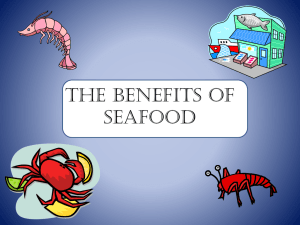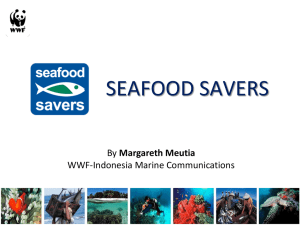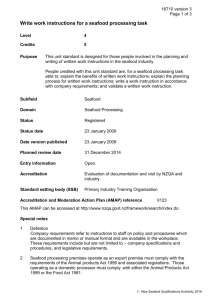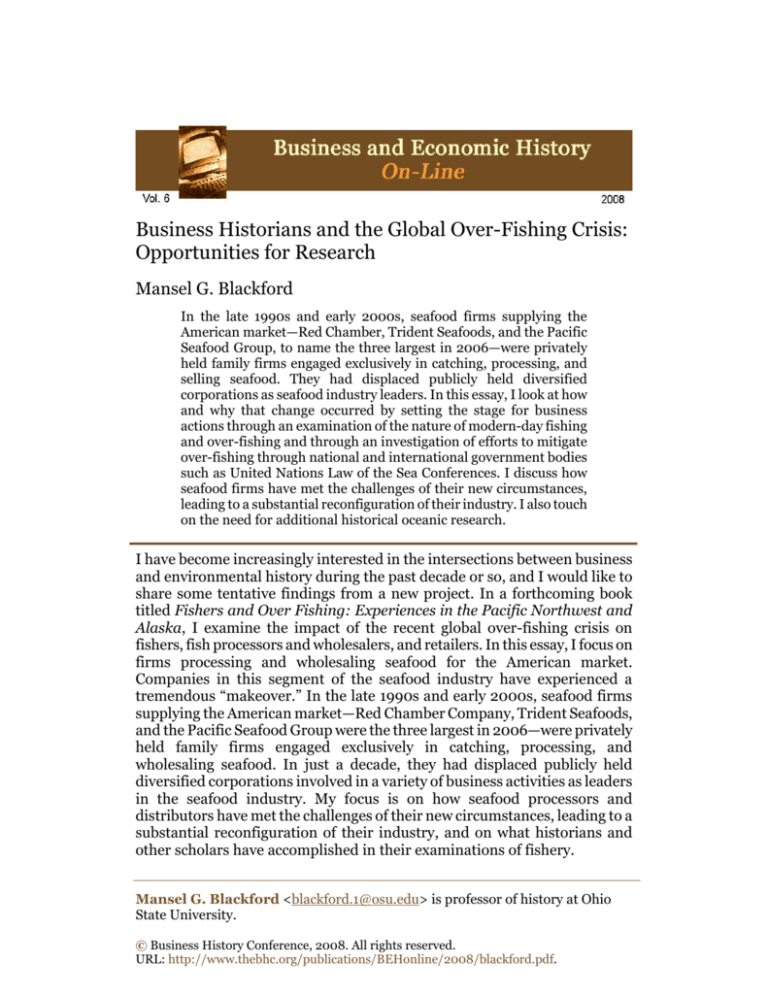
Business Historians and the Global Over-Fishing Crisis:
Opportunities for Research
Mansel G. Blackford
In the late 1990s and early 2000s, seafood firms supplying the
American market—Red Chamber, Trident Seafoods, and the Pacific
Seafood Group, to name the three largest in 2006—were privately
held family firms engaged exclusively in catching, processing, and
selling seafood. They had displaced publicly held diversified
corporations as seafood industry leaders. In this essay, I look at how
and why that change occurred by setting the stage for business
actions through an examination of the nature of modern-day fishing
and over-fishing and through an investigation of efforts to mitigate
over-fishing through national and international government bodies
such as United Nations Law of the Sea Conferences. I discuss how
seafood firms have met the challenges of their new circumstances,
leading to a substantial reconfiguration of their industry. I also touch
on the need for additional historical oceanic research.
I have become increasingly interested in the intersections between business
and environmental history during the past decade or so, and I would like to
share some tentative findings from a new project. In a forthcoming book
titled Fishers and Over Fishing: Experiences in the Pacific Northwest and
Alaska, I examine the impact of the recent global over-fishing crisis on
fishers, fish processors and wholesalers, and retailers. In this essay, I focus on
firms processing and wholesaling seafood for the American market.
Companies in this segment of the seafood industry have experienced a
tremendous ―makeover.‖ In the late 1990s and early 2000s, seafood firms
supplying the American market—Red Chamber Company, Trident Seafoods,
and the Pacific Seafood Group were the three largest in 2006—were privately
held family firms engaged exclusively in catching, processing, and
wholesaling seafood. In just a decade, they had displaced publicly held
diversified corporations involved in a variety of business activities as leaders
in the seafood industry. My focus is on how seafood processors and
distributors have met the challenges of their new circumstances, leading to a
substantial reconfiguration of their industry, and on what historians and
other scholars have accomplished in their examinations of fishery.
Mansel G. Blackford <blackford.1@osu.edu> is professor of history at Ohio
State University.
© Business History Conference, 2008. All rights reserved.
URL: http://www.thebhc.org/publications/BEHonline/2008/blackford.pdf.
Mansel G. Blackford // Business Historians and the Over-Fishing Crisis
2
In the spring of 2007, the anonymous author of an introduction to three
essays in National Geographic warned, ―The oceans are in deep blue trouble.
From the northernmost reaches of the Greenland Sea to the swirl of the
Antarctic Circle, we are gutting our seas of fish. . . . Nets scour reefs.
Supertrawlers vacuum up shrimp. Nations flout laws.‖1 Although this writer
may have exaggerated the extent of over-fishing, there were valid reasons for
concern, for by this time over-fishing had been well documented in numerous
scientific reports.2 In fact, between 1950 and 1990, the global wild fish and
shellfish catch soared from 19 to 94 million metric tons, and it remains at
about this level in 2008.3
The global catch has failed to increase despite a tremendous intensification in fishing efforts. Between 1970 and 1995, the number of fishing
vessels increased from 451,000 to 885,000. During the same years, their
aggregate size rose from 12 million gross registered tons (grt) to 82 million
My thanks to John Brooke, William Childs, Sally Clarke, Mark Rose, Randy Roth,
and David Sicilia for comments on earlier drafts of this paper.
1 Anonymous, ―Introduction,‖ National Geographic 211 (April 2007): 33.
2 See especially Boris Worm et al., ―Impacts of Biodiversity Loss on Ocean Ecosystem
Services,‖ Science Magazine 314 (3 Nov. 2006): 787-90; viewed 15 Nov. 2006. URL:
http://www.sciencemag.org/cgi/content/full/sci;314/5800/787. For comments on
these findings, see Michael J. Wilberg and Thomas J. Miller, ―Comment on ‗Impacts
of Biodiversity Loss on Ocean Ecosystem Services,‘ ‖ Science Magazine 316 (1 June
2007): 1285b; viewed 10 Nov. 2007. URL: http://www.sciencemag.org/cgi/content/
full/sci;316/5829/1285. There are many controversies about fishging and overfishing. For instance, some experts have argued that ―fishing down the food web or
food chain‖ has sequentially destroyed higher-trophic fisheries around the world,
such as that for blue-fin tuna in the North Atlantic. Others have countered that such
events have been rare, and that they have resulted in no net changes, or in increases
in overall fish catches, with the elimination of large predatory fish from ecosystems.
Commenting on this phenomenon in early 2008, fisheries historian Glenn M. Grasso
observed, ―As marine scientists have made clear, the overfishing of megafauna and
apex predators has broad, deleterious results for ecosystems.‖ See Grasso, ―What
Appeared to be Limitless Plenty: The Rise and Fall of the Nineteenth-Century
Atlantic Halibut Fishery,‖ Environmental History 13 (Jan. 2008): 66-91, especially
p. 68.
3 [United Nations Food and Agriculture Organization], Fisheries and Aquaculture
Department, ―Global Capture Production, 1950-2005‖; viewed 17 Oct. 2007. URL:
http://www.fao.org/fi/website/FIRetrieveAction.do?dom=collection&xml=globalcapture-production.xml. UNFAO statistics are only partially reliable, because that
body relies on nations to report catches in their waters. Most researchers believe that
China consistently over-reported catches in the 1990s. On the other hand, UNFAO
statistics do not include fish taken illegally in contravention to international
agreements. For example, the illegal catch in recent years may include 50 percent of
the cod landed in Great Britain and 60 percent of the hake landed in Spain. See
Charles Clover, The End of the Line: How Overfishing Is Changing the World and
What We Eat (New York, 1996), 7-24, 168-69; and Callum Roberts, The Unnatural
History of the Sea (Washington, D.C., 2007), 317-30.
Mansel G. Blackford // Business Historians and the Over-Fishing Crisis
3
grt. An increasing proportion of these ships were fast diesel- and gasolinepowered vessels that were much more efficient than earlier ships in catching
fish. The vessels used a broad array of sophisticated technological devices
such as radar, sonar, loran, and global positioning systems to find fish. They
caught fish with lines up to 62 miles in length and with tens of thousands of
hooks, by dragging huge trawl nets across the ocean bottom (by the 1990s, a
single trawl net might be large enough to hold a fleet of twelve Boeing 747
jumbo jets), and by deploying gigantic purse-seine nets made of light but
strong synthetic fibers. The intensity of fishing for wild fish and crustaceans
increased substantially faster than did the size of the fishing catch after about
1970. More ships with better equipment made smaller catches per unit of
effort. Fishing for many species got harder. Profits became less assured for
many fishing companies in the 1980s, the 1990s, and later.4
Efforts to regulate fishing internationally began in the late 1950s and
early 1960s. They accomplished little, however, until the 1970s, when many
nations declared 200-mile exclusive economic zones (EEZs) out from their
shorelines. The United States proclaimed such a zone in 1976 with the
passage by Congress of the Federal Fishery Conservation and Management
Act (reenacted in 1996). This legislation extended the federal government‘s
control over oil, minerals, and fish 200 miles out to sea, banning foreign
fishers from American waters.
Authors of international and national fishing agreements, especially
those that created EEZs, tried to retain fishery resources for their nationals.
Many were also interested in making fishing within their EEZs sustainable by
placing limits on fish catches. The United States formed eight regional
management councils to set and administer Total Allowable Catches (TACs)
for different types of fish in their areas. The councils often divided the TACs
among fishers, giving them individual transferable quotas (ITQs), thus
virtually vesting them with property rights in their fish stocks. The ITQs
usually gave fishers rights to a certain percentage of the annual catch of
specified fish stocks.
The use of TACs and ITQs sought to avoid a possible ―tragedy of the
commons‖ in fisheries.5 In some cases, TACs and ITQs succeeded in ending
over-fishing, as in some Alaskan fisheries, but in many others they were
UNFAO, Fisheries and Aquaculture Department ―Fishing Effort, 1970-1995‖;
viewed 16 Nov. 2007. URL: http://www.fao.org/figis/servlet/SQServlet. See also
Suzanne Iudicello, Michael Weber, and Robert Wieland, Fish, Markets, and Fishers:
The Economics of Overfishing (Washington, D.C., 1999), 12, 17, 20-22; Roberts,
Unnatural History, 305-15; and Colin Woodard, Ocean’s End: Travels through
Endangered Seas (New York, 2000), 238.
5 Garrett Hardin, ―The Tragedy of the Commons,‖ Science Magazine 162 (13 Dec.
1968): 1243-48, is the classic statement on this topic. For valuable discussions of the
tragedy of the commons in fisheries, see Clover, End of the Line, 141-65, and Arthur
F. McEvoy, The Fisherman’s Problem: Ecology and Law in the California Fisheries,
1850-1980 (New York, 1986), 10-12.
4
Mansel G. Blackford // Business Historians and the Over-Fishing Crisis
4
difficult to implement, leading to continued over-fishing. The combination of
over-fishing in some regions with successes in sustainable-yield fishing in
other areas created challenges for suppliers of seafood for global markets.
Perhaps nowhere was the complexity of the situation greater than in the
provision of seafood for the American market. In these uncertain times,
seafood executives adopted new approaches to business, altering in major
ways the composition of their industry. A relatively small number of leading
suppliers and processors have controlled ―chokepoints‖ in the American
seafood industry. They purchase fish from thousands of fishers, process it,
and distribute it to additional thousands of retail outlets, mainly grocery
stores and restaurants.
It would be valuable to know how over-fishing has affected suppliers,
especially their strategies for survival. What does over-fishing mean for
company strategies and structures? Scholars are just beginning to understand
the impacts that environmental issues have had on corporate growth.
Historian Christine Rosen, for example, has recently shown that
environmental protests led American meatpackers to change how they
handled industrial waste in the nineteenth century and how, in turn, those
alterations affected corporate structures, leading to vertical integration.6
Have environmental responses to over-fishing informed the actions of
seafood executives?
My preliminary research suggests that today‘s fishing problems have
affected seafood processors and suppliers in both expected and unexpected
ways. An examination of the largest suppliers for the U.S. seafood market
between 1999 and 2006 reveals both continuity and change in their
operations. Comparative company data, collected and reported by the
industry trade journal Seafood Business, are currently available only for those
seven years.
There are several elements of continuity. The top twenty-five suppliers
accounted for roughly the same proportion of wholesale seafood sales made
in the United States over those seven years: $11 billion of a total $24 billion in
1999, and $13 billion of $33 billion in 2006. Numerous smaller suppliers
provided the remainder. The largest five or six American suppliers remained
about the same in size, ranging between about $500 million to $1 billion each
in annual sales. Throughout the early 2000s, the suppliers participated, as in
earlier years, in the global economy. They both imported and exported
seafood, with imports running ahead of exports by about three to one.7
Christine Meisner Rosen, ―The Role of Pollution Regulation and Litigation in the
Development of the U.S. Meatpacking Industry, 1865-1880,‖ Enterprise & Society 8
(June 2007): 297-347.
7 These sales compared to the $8.4 billion in combined global seafood sales made by
the Japanese giants Maruha Group and Nichiro Corporation in 2006. Those
companies, then the world‘s largest and third-largest suppliers of seafood, merged
late that year. The second-largest global seller was Nippon Suisan Kaisha, Ltd.,
another Japanese company. Through an American subsidiary, Nippon Suisan USA,
6
Mansel G. Blackford // Business Historians and the Over-Fishing Crisis
5
Although continuity characterized some of the operations of the leading
suppliers for the American market, major alterations also occurred. Most of
the large diversified American companies dropped out of the seafood
business over these seven years. By 2007, StarKist Seafoods, the world‘s
leading packer of canned tuna, remained the only top-ten seafood producer
owned by a big diversified American firm. Late in 2002, the H. J. Heinz
Company sold StarKist to Del Monte Foods, and Del Monte remained its
owner five years later. Managers of many of the large diversified food
companies found that they lacked the specialized knowledge and sources of
raw seafood needed to prosper in the tough environment of increased
product scarcity. Financial muscle was not by itself sufficient.8
Focused privately held family seafood companies replaced diversified
publicly owned food giants as the top suppliers of seafood for the American
market. The leading three U.S. seafood suppliers in 2006—the Red Chamber
Company, Trident Seafoods, and the Pacific Seafood Group—were familyowned and family-operated. As in many industries in the United States and
abroad, the trend in business strategy was to return to what companies did
best: ―to get back to the knitting.‖9 Moving away from diversification was part
of that trend, a reversal of the earlier movement toward the development of
large, diversified, multidivisional corporations so capably written about by
historian Alfred D. Chandler, Jr.10
The three top American seafood firms shared historical and structural
characteristics. They had humble origins; one began as a family restaurant,
another as a single-ship operation, and the third as a small retail seafood
sales counter. Each expanded through a combination of internal growth and
acquisitions. Family funds and retained earnings seem to have been the main
sources of capital, at least initially. Vertical integration assured that the
companies would have access to supplies of seafood. Alaskan waters, in which
sustainable fishing developed, were major sources of seafood for all three
companies, which were West Coast firms. The three companies processed and
Nippon Suisan owned American suppliers Fishking, Gorton‘s Seafoods, Unisea, and
several others. Nippon Suisan made about 12% of its global sales in North America in
2006; see Seafood Business 19 (Feb. 2000): 1, and 26 (16 July 2007): 1; viewed 17
July 2007 and 16 July 2007, respectively. URLs: http://www.find.galegroup.com
and http://www.seafoodbusiness.com. On Nippon Suisan, see ―Investor Relations,
Balance Sheet, 2006‖; viewed 26 July 2007. URL: http://www.nissui.co.jp/english.
8 Seafood Business 19 (Feb. 2000): 1; 20 (Feb. 2001): 1; 21 (May 2002): 1; 22 (May
2003): 1; 23 (May 2005): 1; 24 (May 2005): 1; 25 (May 2006): 1; viewed on 17 or 23
July 2007. URL: http://www.findgalegroup.com. For 2006 sales, see Seafood
Business 29 (May 2007): 1; viewed 23 July 2007. URL: http://www.seafoodbusiness.
com.
9 Thomas Peters and Robert Waterman, Jr., In Search of Excellence: Lessons from
America’s Best-Run Companies (New York, 1982), 292, coined this phrase.
10 Alfred D. Chandler Jr., The Visible Hand: The Managerial Revolution in
American Business (Cambridge, Mass., 1977).
Mansel G. Blackford // Business Historians and the Over-Fishing Crisis
6
sold a wide variety of seafood, about which their owners had detailed
knowledge, and did not venture into other fields.11
Of course, not all of the United States‘ leading seafood suppliers were
privately held family firms. Like the top three suppliers of the American
seafood market, the next largest seven dealt almost exclusively in seafood,
were worldwide in their reach, and had multiple sources for their raw
products. Unlike the largest three, many of the remaining top ten were not
family-owned firms. Four of them were subsidiaries of foreign companies.12
As it had long been, the seafood industry remained complex in shape, global
in scope, and susceptible to rapid change brought about by alterations in
technologies, laws, and markets.
This brief analysis suggests, I hope, the need for additional historical
research on changes in the seafood industry. The first need is for historical
perspective on today‘s problems. Historians could show, for example, that
global over-fishing, while a greater problem than ever before, is not new.
They could relate how people have dealt with fisheries management and
provide analyses of both failures and successes. Historians have documented
past success stories. For example, Richard W. Judd, in Common Lands,
Common People: The Origins of Conservation in Northern New England,
examines the partial success of commons fisheries management in early-day
New England. Community norms and customs, Judd persuasively argues,
encouraged New Englanders to manage their fisheries in sustainable ways
well into the 1800s, suggesting that there need not be a tragedy of the
commons.13
Second, historians might fully discuss how the interactions among legal,
scientific, economic, and social developments have affected fisheries. For
example, in his superb book, The Fisherman’s Problem: Ecology and Law in
the California Fisheries, 1850-1950, Arthur McEvoy looks at how numerous
environmental, legal, and economic factors intertwined over more than a
century to affect fisheries, particularly the sardine fishery. Similarly, in his
Making Salmon: An Environmental History of the Northwest Fisheries,
Joseph E. Taylor III has shown particularly well how interactions between
natural events and human actions decimated salmon fisheries in the Pacific
Northwest, especially on the Columbia River. Historians, trained to deal with
complexities, are especially well suited to conduct research on the overfishing crisis. Like ecologists, historians generally adopt holistic approaches.14
Laine Welch, ―A Look at the Top Seafood Firms Show Promising Future,‖ Alaska
Journal (1 July 2007) unpaginated, viewed 16 July 2007. URL: http://www.
alaskajournal.com.
12 Seafood Business (29 May 2007), 1.
13 Richard W. Judd, Common Lands, Common People: The Origins of Conservation
in Northern New England (Cambridge, Mass., 1997).
14 McEvoy, Fisherman’s Problem; and Joseph E. Taylor III, Making Salmon: An
Environmental History of the Northwest Fisheries Crisis (Seattle, Wash., 1999).
11
Mansel G. Blackford // Business Historians and the Over-Fishing Crisis
7
Third, historians can help provide a close look at the taking of specific
types of fish around the world. Although scholars know a good deal about the
history of the Atlantic cod and the Pacific salmon, the development and
exploitation of many other fish stocks are just beginning and need additional
historical investigation. Too often, scientists have little knowledge of the
extent of past fish stocks and no baselines on which to construct their work
and make policy recommendations. Historical research could help fill such
gaps. However, historians must exercise caution to keep their goals and
agendas foremost, lest they be co-opted by scientists, especially marine
biologists.15
Fourth, historians can put a human face on fishery matters and offer
insights into what fisheries‘ booms and busts have meant to people and their
communities. Historians have dealt with the issues of deindustrialization,
and the decline of commercial fishing communities is similar. So far,
however, community issues have been looked at primarily by journalists and
novelists. One common point in their writings, which historians might
pursue, is the number of declining fishing communities that have tried to
shift their economic bases to tourism, especially heritage tourism. These
efforts have had only limited success; tourism has not saved fishing
communities.16
Finally, historians might investigate how the popular image of the ―tough
fisherman against the cruel sea‖ has contributed to over-fishing. Public
images are important (perhaps most important) even when they are at odds
See, for example, Hrefna Karlsdottir, Fishing on Common Grounds: The
Consequences of Unregulated Fishing of North Sea Herring in the Postwar Period
(Goteborg, Sweden, 2005). Fishing on the Great Lakes is examined in Margaret
Bogue, Fishing the Great Lakes: An Environmental History (Madison, Wisc.,
2000); and Kristin M. Szylvian, ―Transforming Lake Michigan into the ‗World‘s
Greatest Fishing Hole‘: The Environmental Politics of Michigan‘s Great Lakes Sport
Fishing, 1965-1985,‖ Environmental History 9 (Jan. 2004): 102-27. On California‘s
tuna fishery, see Michael K. Orbach, Hunters, Seamen, and Entrepreneurs: The
Tuna Seinermen of San Diego (Berkeley, Calif., 1977). On the shad of New England,
see Daniel Vickers, ―Those Damned Shad: Would River Fisheries of New England
Have Survived in the Absence of Industrialization?‖ William & Mary Quarterly, 3d
ser., 61 (Oct. 2004): 685-712.
16 See E. Annie Proult, The Shipping News (New York, 1994), a Pulitzer Prize–
winning novel; and Sebastian Junger, Perfect Storm (New York, 1997) (as well as the
motion pictures with the same titles). Michelle Chalfoun, The Width of the Sea (New
York, 2001), and Donna Morrissey, Sylvanus Now (New York, 2005), are set in
fishing communities in modern-day New England and Newfoundland, respectively.
On the demise of La Poile, a fishing town in Newfoundland, see Chris Carroll, ―End
of the Line,‖ National Geographic 211 (April 2007): 91-99. See also William B.
McCloskey, Jr.‘s fictional trilogy about fishing in Alaskan waters: Highliners (New
York, 1979), Breakers (Guilford, Conn., 2000), and Raiders (Guilford, Conn., 2004).
For a fictional look at a modern-day dying fishing town on the Texas Gulf Coast, see
William J. Cobb, Goodnight, Texas (Denver, Colo., 2006).
15
Mansel G. Blackford // Business Historians and the Over-Fishing Crisis
8
with reality. The persistence of the image of the rugged, individualistic angler
in a time of industrialized commercial fishing needs exploration, perhaps by
cultural historians.17
Historians working on fishing problems would be laboring at significant
intersections in the splintered discipline of history, encouraging the
integration of legal, political, environmental, and business history. Until very
recently, most business historians have been slow to examine environmental
issues. Focusing especially on the business firm and its management, they
have not usually probed deeply into the externalities that helped frame
business actions.18 Looking at fisheries could be an important way to examine
a relatively understudied facet of capitalism, shedding new light on the nature
of relationships among communities, business groups, and governments
worldwide. In addition, examining fisheries might also lead historians to
examine in new ways topics with which they are already engaged: interplays
between the development of global markets and the international regulation
of business; connections among developments in science, technology, and
industrialization; the commodification of food products; and intersections
between capitalism and property rights.
For examples of this image in literature, see Rudyard Kipling, Captains
Courageous: A Story of the Grand Banks (London, 1897); and Ernest Hemingway,
The Old Man and the Sea (New York, 1952). The recent television series on the
Discovery Channel, ―The Deadliest Catch,‖ perpetuates this image.
18 Historians Christine Rosen and Christopher Sellers observed in 1999, ―Business
history has never paid much attention to the environment,‖ and in fact has given
―little attention to the effects of resource extraction and use on plants, animals, land,
air, or water, much less entire ecosystems and climate.‖ That situation has begun to
change, as business historians have increasingly looked at connections among
business firms, their societies, and their cultures. See Christine Meisner Rosen and
Christopher C. Sellers, ―The Nature of the Firm: Towards an Ecocultural History of
Business,‖ Business History Review 73 (Winter 1999): 577-600, especially 577. That
issue of the Business History Review is devoted to relationships among businesses
and the environment, as is Enterprise & Society 8 (June 2007). See also Christine
Rosen, ―The Business-Environment Connection,‖ Environmental History 10 (Jan.
2005): 77-79.
17

